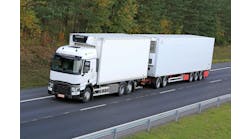There's Hope for Congestion Relief at the West Coast Ports
PierPass Inc. and Ability/Tri-Modal Transportation Services Inc. have released the results of a study that uses global positioning system (GPS) tracking to provide a common language and set of facts that the port community can use to discuss truck queuing and terminal visit times at the Port of Los Angeles and Long Beach.
“Truckers and terminal operators have often talked past one another, with truckers relying on anecdotes and emphasizing extreme instances of delay, and terminals quoting gate records that don’t count wait times outside the gates,” says Val Noronha, president of Digital Geographic Research Corp. (DGRC), which conducted the study. “Both have used a metric (turn times) that means different things to different people. With objective, technology-based metrics of throughput that address all phases of a port visit, terminal operators and truckers will have a solid foundation upon which to build efficiency solutions.”
The study evaluates three time periods: queue time, spent waiting in line outside the gates; terminal time, measuring from the entry gate to the exit gate; and visit time, the sum of queue and terminal time.
Key findings of the study include:
● The median queue time in October was 20 minutes and the terminal time 31 minutes, for a total median visit time of 51 minutes.
● The vast majority of visits take less than two hours: 27% are under 30 minutes, 58% under an hour, 75% under 1 1/2 hours, and 86% under two hours. A further 12% of visits take two to four hours, and 1% to 2% of visits take between four and eight hours.
● About 91% of queue times were under an hour.
● The median queue and visit times include trucks that choose to arrive early to wait for the 6:00 p.m. off-peak to start.
● The study found that daytime visits are shortest for trucks that arrive at 15:00 (3:00 PM). Median visit time for trucks arriving between 15:00 and 16:00 was 45 minutes, while for trucks arriving between 17:00 and 18:00 median visit time was 90 minutes, reflecting the 17:00 meal break.
● Wait times increase around breaks and shift starts.
● When cargo volumes rebounded in the spring and summer of 2010, terminal operators opened additional service hours to hold down congestion. Those investments proved effective: while cargo volumes increased 6% from May to October, visit time decreased 13%, the study showed.
● For the longest 10% of visits, the improvement from May to October was even better, at 15%.
The Truck Turn-Time Stakeholder Group (TTSG) was formed in July 2010 to address concerns about visit times. It includes representatives of trucking companies, marine terminal operators, cargo owners and the two ports.
“The past year has really pushed us, as a community, to look to the future and plan ahead more than we have in the past,” says Joshua Owen, president of Ability/Tri-Modal, a trucking, warehousing and distribution company. “This study is part of the community’s effort to come together and discuss solutions that benefit all of us. The results from the study will help us identify periods of congestion as well as where there is room for increased capacity. It’s now the responsibility of the TTSG to continue to meet to identify and resolve potential issues to ensure continued efficiency in the Port of Los Angeles and Long Beach.”
PierPass contracted DGRC on behalf of TTSG to conduct this study, with funding from PierPass, Ability/Tri-Modal, the Port of Long Beach and the Port of Los Angeles. It relied on GPS devices installed in about 250 trucks at the ports under a research project funded by the U.S. Department of Transportation’s Research and Innovative Technology Administration.
Bruce Wargo, president of PierPass, notes that the queue and visit time measurements include a significant proportion of visits involving two transactions (typically, dropping off an empty container and picking up a loaded container, or vice versa). Separately measuring the single-transaction and double-transaction visit times was beyond the scope of this study.
“The study points to ways to further increase efficiency of container moves,” Wargo says. “Trucking companies can reduce wait times by avoiding breaks and shift changes and arriving during underutilized hours. Terminal operators should carefully review their lunch hour and break practices to minimize the amount of waiting in the yard.”
PierPass is a non-profit formed by the West Coast MTO Agreement (WCMTOA) in 2005 to address marine terminal issues at the ports of Los Angeles and Long Beach, such as congestion, security and air quality. Under the program, all international container terminals in the two ports established five new shifts per week. As an incentive to use the new off-peak shifts and to cover the added cost of the shifts, a traffic mitigation fee (TMF) is required for most cargo movement during peak hours (Monday through Friday, 3 a.m. to 6 p.m.).


